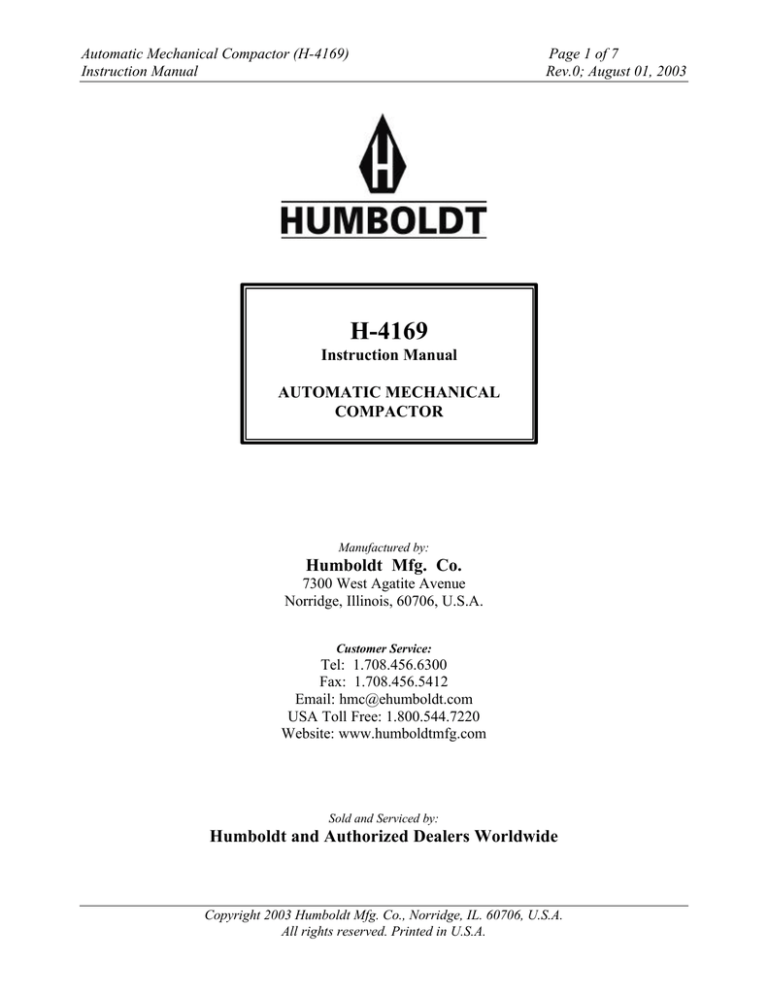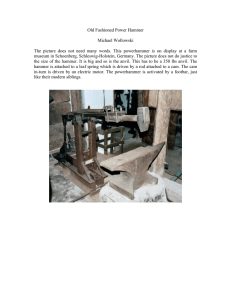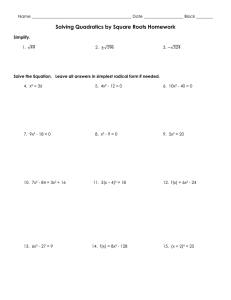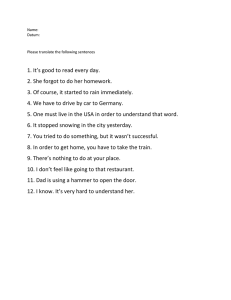
Automatic Mechanical Compactor (H-4169)
Instruction Manual
Page 1 of 7
Rev.0; August 01, 2003
H-4169
Instruction Manual
AUTOMATIC MECHANICAL
COMPACTOR
Manufactured by:
Humboldt Mfg. Co.
7300 West Agatite Avenue
Norridge, Illinois, 60706, U.S.A.
Customer Service:
Tel: 1.708.456.6300
Fax: 1.708.456.5412
Email: hmc@ehumboldt.com
USA Toll Free: 1.800.544.7220
Website: www.humboldtmfg.com
Sold and Serviced by:
Humboldt and Authorized Dealers Worldwide
Copyright 2003 Humboldt Mfg. Co., Norridge, IL. 60706, U.S.A.
All rights reserved. Printed in U.S.A.
Automatic Mechanical Compactor (H-4169)
Instruction Manual
Page 2 of 7
Rev.0; August 01, 2003
TABLE OF CONTENTS
Page
1.
Introduction
……………………………………
3
2.
Operation
……………………………………
4
3.
Warranty
……………………………………
7
4.
Drawing
……………………………………
7
Copyright 2003 Humboldt Mfg. Co., Norridge, IL. 60706, U.S.A.
All rights reserved. Printed in U.S.A.
Automatic Mechanical Compactor (H-4169)
Instruction Manual
1.
Page 3 of 7
Rev.0; August 01, 2003
Introduction
It is recommended that these instructions be read through to become thoroughly familiar
with the operation of the machine before attempting to run it.
The Mechanical Compactor more closely duplicated hand compaction methods and
results. It is suitable for standard or modified proctor compaction tests with adjustment
for 12” or 18” drop and accommodating 4” or 6” inside diameter molds. Test result show
that the Humboldt Compactor can give results within 1% when compared with hand
compaction on a 4” diameter mold.
It is recommended for any automatic compaction machine that it be bolted to a concrete
floor or mounted on a concrete base. We recommend a base approximately 15” wide x
24” deep x 12 to 18” high. The machine should be firmly bolted in position. The bolt
holes are 10 5/8” centers and with 14 ½” centers in depth. The machine should be set
level, checking that the turntable is level in both directions.
The electric cord should be plugged into a convenient receptacle of the correct voltage.
One of the hammers that are packed separately for shipping, should be inserted into the
hammer cage, the round type 4” mold or wedge foot for 6” diameter mold. In order to
perform this operation proceed as follows:
1.1
Open the sheet metal doors by means of a front latch.
1.2
Place a mold on the turntable. A ¼” diameter pin 1/8” high extends from the
center of the turntable. This pin is used to locate the mold. After locating the
mold in position, bolt it down to the table. Two sets of holes are located on the
base plate for mounting, one for the 4” diameter mold and one for the 6”
diameter mold.
1.3
By means of the jog switch located on the right hand side of the machine, run the
machine until the carriage is in the upper most position, this will withdraw the
hammer-lifting bolt to its rearward position. The hammer-lifting bolt is situated
at the top of the carriage. (See also notes on the hammer-lifting mechanism).
1.4
Remove the front cage bar by pulling down the spring-loaded retaining pin on
top of it and lift out. Insert hammer with foot down into the hammer cage from
the front of machine. Slide hammer down slow, do not drop, taking care not to
trap fingers. Replace front cage bar.
1.5
The hammer can now be lifted by manipulating the jog switch, until it is high
enough to place a mold on the turntable. Close the hinged cover and secure the
latch.
Copyright 2003 Humboldt Mfg. Co., Norridge, IL. 60706, U.S.A.
All rights reserved. Printed in U.S.A.
Automatic Mechanical Compactor (H-4169)
Page 4 of 7
Instruction Manual
Rev.0; August 01, 2003
1.6
Whenever a mold is being changed or inspected, run the hammer up in the
machine by means of the jog switch. Then swing the hammer safety arm, painted
yellow, under the hammer opening. If the hammer should float down from its
own weight, it will come to rest on this safety device. When ready to proceed
with the testing, just jog the hammer up and swing the safety arm out of the way
to the right.
2.
Operation
2.1
For Compaction with a CBR Mold, 6” Inside Diameter
Place the first layer of soil (in the case of AASHTO compaction, one-fifth by
weight of the expected final total specimen weight) in the mod and place the mold
in position on the turntable and clamp tightly. The height change cam should be in
the top position for 18” drop. (See Height Change Cam Instructions) Set the predetermining counter to 54 (See Instructions for Pre-determining Counter). This will
insure that 55 blows are struck; at the end of said number the machine will
automatically stop. Press the green start button on the right hand side of the
machine. Immediately the carriage will rise lifting the hammer until such time as
the hammer-lifting bolt is withdrawn by the uppermost cam on the carriage guide
bar. The hammer will fall and as the carriage completes its cycle, it will pick up
again. As the carriage rises lifting the hammer with it, the table-rotating switch is
accuated, which accuates the timing circuit, which accuates the turntable. For
further details see below under Table Mechanism.
The machine will continue to run until such time as 55 blows have been struck.
When the machine stops, the hammer should be lifted by means of the jog switch
and an additional layer of soil placed in position in the mold and roughly leveled.
Reset the predetermining counter to 54 blows and repeat as above. Continue until
all five layers have been compacted. The collar should be on the mold at least for
the last two layers.
In using a 6” inside diameter mold the wedge foot hammer must be used. See
Hammer Instructions and Table Adjusting instructions.
2.2
For Compaction with Proctor Mold, 4” Inside Diameter
Remove hammer from machine and arrange it for the 5- ½ lb. total weight. (See
Hammer Instructions) Replace hammer.
Place first layer of soil (in case of AASHTO compaction test, one-third of expected
total final weight) in the mold and place the mold in position on the turntable and
clamp tightly.
See that the height change cam is set for 12” drop. (See Height Change
Instructions)
Copyright 2003 Humboldt Mfg. Co., Norridge, IL. 60706, U.S.A.
All rights reserved. Printed in U.S.A.
Automatic Mechanical Compactor (H-4169)
Page 5 of 7
Instruction Manual
Rev.0; August 01, 2003
Set the predetermining counter to 24 and press start button on machine. Machine
will continue to run until 25 blows have been struck. Raise hammer by using jog
switch, add second layer of soil and repeat. Repeat for third layer of soil.
2.3
Table Mechanism
The table mechanism assembly is fitted to and contained within the base of the
machine. The table is rotated by a Slo-Syn motor. As the table-rotating switch,
#701, is depressed, the table begins to rotate. The amount of rotation of the
turntable can be controlled by the time delay circuit located in the switch box on
the right side of the machine. Turn the knob clockwise for more rotation or counter
clockwise for less.
Before starting the machine up the first time, turn the knob all the way to the left.
Start machine without hammer, turn knob slowly to the right until the desired
amount of index is accomplished. The knob setting can then be left set, except only
for minor adjustments.
2.4
Table Adjustment
Loosen 4 hex bolts on the table-mounting base. The whole assembly now can be
slid in or out for adjusting clearance between hammer and inside diameter of mold.
This adjustment must also be made when changing from one size diameter mold to
another.
2.5
Predetermining Counter
To set the predetermining counter, simply rotate dials until desired number appears
in view. Always set counter one number less than the needed for test.
2.6
Height Change Mechanism
The top cam, #413 is located on the cam bar, #1410, at the rear of the carriage. The
cam disengages the catch, #304 and causes the hammer to fall. There are two
positions in which this cam can be placed. The lower position will release the
hammer for a 12” drop and the upper position will release the hammer for an 18”
drop. To change the cam from one position to another, it is only necessary to
remove the socket cap crew. The cam is inserted in a slot and can be pulled out by
hand. If it is rather tight, use a pair of pliers to remove it. Insert in the desired
position and replace the socket cap screw, making sure that the screw is drawn up
tight and that no part of the screws extends above the surface of the 5/8” round cam
bar.
2.7
Hammer Lifting Mechanism
A ½ H.P. electric motor fitted with a reduction gearbox drives and endless chain. A
link on this chain carried a spindle that fits into a bronze block. The bronze block
Copyright 2003 Humboldt Mfg. Co., Norridge, IL. 60706, U.S.A.
All rights reserved. Printed in U.S.A.
Automatic Mechanical Compactor (H-4169)
Page 6 of 7
Instruction Manual
Rev.0; August 01, 2003
slides in a horizontal groove in the carriage, #2301. The carriage slides in a vertical
direction on two steel guide bars. The cam bar, #1410, has a slot at the upper end in
which the top cam, #413, is located. In a slot at the lower end, the pick-up cam,
#414, is located, it is spring-loaded. With the carriage in the low position, the
spring-loaded cam will push the catch #304, into the hammer grooves. The carriage
will carry the hammer up where the top cam pulls the catch back and drops the
hammer.
The motor and the idler gear that carry the endless chain are sealed ball bearings
and need no lubrication. The carriage guide bar and the horizontal slot in the
carriage should be kept well lubricated with light grease. A molybdenum type
lubricant can be used such as Molycoat G Paste or Molycoat G Spray made by the
Alpha-Molycoat Corporation.
2.8
Chain Adjustment
With the carriage in the down position, one should be able to move the chain about
¼” sideways. If it gets to be a lot more it can break the micro switch. To adjust,
loosen the 4 bolts holding the idler. Push idler up with the ¼ “ bolt under the idler
shaft. Then tighten bolts again.
2.9
Hammer
The hammer is guided in its free fall by three vertical rods. The removable rod,
#403, acts as a guide to keep the pie hammer from rotating. It is necessary to keep
it from rotating when using the pie foot in a 6” inside diameter mold. The hammer
with 2” diameter foot or the hammer with the pie foot weigh 5.5 lbs. To use either
hammer and obtain a weight of 10 lbs., a weighted plug is used. It is inserted into
the top of the hammer and held in place with a socket head cap screw. Never drop
hammer on turntable or in empty mold.
2.10 Hammer Note
On some models the notches on the hammer are eliminated toward the top, so it
will not be picked up if no mold is on the table or if mold is empty. To allow pick
up of hammer, place a board on top of mold and rest hammer on it. Manipulate jog
switch and hammer will be picked up.
2.11 Molds
The molds are made special for the compactors. If replacement were needed, it
would be best to buy them through your dealer or direct from us.
4” mold
6” mold
4” split mold
6” split mold
H-4169.4
H-4169.6
Copyright 2003 Humboldt Mfg. Co., Norridge, IL. 60706, U.S.A.
All rights reserved. Printed in U.S.A.
Automatic Mechanical Compactor (H-4169)
Instruction Manual
3.
Warranty
Page 7 of 7
Rev.0; August 01, 2003
Humboldt Mfg. Co. warrants its products to be free from defects in material or
workmanship. The exclusive remedy for this warranty is Humboldt Mfg. Co., factory
replacement of any part or parts of such product, for the warranty of this product please
refer to Humboldt Mfg. Co. catalog on Terms and Conditions of Sale. The purchaser is
responsible for the transportation charges. Humboldt Mfg. Co. shall not be responsible
under this warranty if the goods have been improperly maintained, installed, operated or
the goods have been altered or modified so as to adversely affect the operation, use
performance or durability or so as to change their intended use. The Humboldt Mfg. Co.
liability under the warranty contained in this clause is limited to the repair or
replacement of defective goods and making good, defective workmanship.
CAUTION: Keep hands, clothing and other objects away from
moving parts when the machine is in operation.
4.
Drawing
H-4169
Copyright 2003 Humboldt Mfg. Co., Norridge, IL. 60706, U.S.A.
All rights reserved. Printed in U.S.A.



